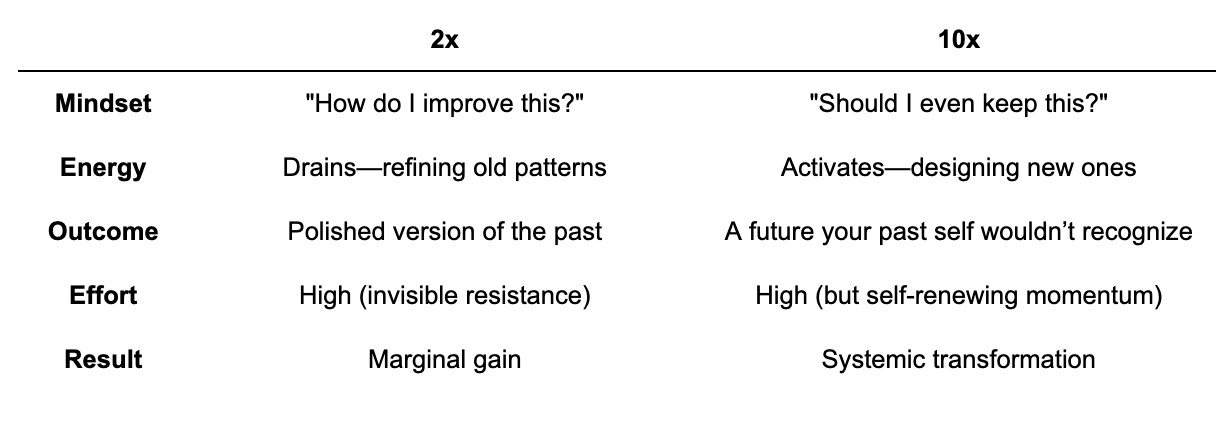
P.S. after my post on Third-Order Thinking, many of you asked how I actually track all this.
So I’m sharing my personal Notion template.
It takes 5 minutes a day, often less.
It’s how I monitor hidden patterns, avoid building traps, and run regular life audits that don’t drain me.
👉 Join the waitlist here to get access (and maybe a sweet offer) when it drops.
Truly thank you for reading. Means everything to me if any of it made you stop and reflect even for a moment. Now for the post…
We’ve been taught to think in terms of better:
Work harder. Focus more. Cut distractions. Refine the model.
This is the logic of 2x.
It feels ambitious, even right, but in practice, it’s often just an elegant form of stagnation.
You scale what you already know. You build on what already exists. You squeeze more out of the current system assuming the system is worth keeping.
But here’s the counter-intuitive truth:
The effort it takes to 10x is often easier than the effort it takes to 2x.
2x is effort inside your current identity.
10x is exiting the identity altogether.
Big change creates fresh energy. Small change recycles tired energy.
The myth of more: why 2x is a trap
Even though we think we act otherwise, we’re conditioned to believe that growth is linear.
“Don’t leap.”
“Don’t burn bridges.”
“Don’t disrupt too much too soon.”
So we aim for 2x. It feels safer. Even smarter.
But it still costs everything.
You still wake up optimizing the same broken routines.
You still justify the same trade-offs with slightly better perks.
You still stay in the job, relationship, or schedule that “isn’t bad”—just bearable.
The real battle isn’t tactical. It’s existential.
You're not fighting time. You're fighting the frame.
Why 10x is easier than 2x
It sounds counterintuitive, but the logic is simple:
Radical change renews you. Marginal change exhausts you.
Here’s why aiming for 10x is easier than chasing 2x:
10x forces clarity; 2x allows confusion
10x demands a singular focus. It forces you to get clear on what actually matters.
2x lets you hide in marginal improvements and fuzzy priorities.10x creates pull; 2x relies on push
When the goal is bold, the energy is magnetic. You're pulled by vision, not by obligation, or constant discipline to stay afloat.10x invites help; 2x stays solo
Audacious moves attract attention, support, and new collaborators.
2x doesn’t spark that same curiosity or momentum. It keeps you quietly grinding alone.10x demands better tools; 2x reuses old ones
2x tries to squeeze more out of a system that’s already at capacity. You have to invent or upgrade your systems to go 10x. That’s where breakthrough happens.10x gives you permission to change identity; 2x reinforces the old one
2x just polishes the persona you’re already tired of performing. At 10x, you get to become someone new, or maybe, become again who you always were.10x disrupts inertia; 2x negotiates with it
Big moves snap you out of autopilot. Small ones let you stay the hamster wheel.10x makes failure useful; 2x hides it
With 2x, mistakes get buried in ambiguity, or familiarity. When you go big, the feedback is loud and fast.
2x = maintenance. 10x = liberation.
Here’s how they really compare.
How to make the 10x shift
1. Catch yourself optimizing an old broken system
Ask:
“Am I trying to make this better. Or am I just afraid to let it go?”
“Would a 10x version of me even be playing this game?”
If your answers feel safe but small, you’re in a 2x trap.
Action:
Pick one area—career, relationship, schedule, health.
Stop improving it. Start reimagining it.
2. Design your dimensional jump
Ask:
“What rules am I unconsciously following?”
“What if the opposite were true?”
“If I started from zero, what would I never carry forward?”
Action:
Write your 10x worldview. Not in volume, but in values.
Who are you? What are you no longer tolerating? What does your new logic look like?
2x tweaks. 10x rebuilds.
The question isn’t “What’s next?”
It’s: “What system do I want to exist in?”
3. Build “minimum viable rebellion”
10x doesn’t start with fireworks.
It starts with subtle rejection of your current frame.
Action:
Pick one defiant move.
Say no to a recurring obligation.
Cancel a plan you’re only keeping out of guilt.
Invest time in something that doesn’t yet “make sense”, but excites you anyway.
Create productive tension between your present and future self.
4. Surround yourself with 10x operators
10x shifts rarely happen in isolation. They’re contagious, sparked by people who think in systems, bet on boldness, and refuse to trade clarity for comfort. Spend enough time around them to learn by osmosis.
Action:
Find people whose presence recalibrates your ambition. People who live in the dimension you’re aiming for, not because they’re better, but because they remind you what’s possible.
Closing thought
A lot of us aren’t stuck in bad lives.
We’re stuck in almost good ones. The kind that feel responsible, functional, “fine,” but quietly demands all your energy just to maintain them, let alone slightly improve them.
It feels safer. Familiar. Respectable.
But 2x keeps you loyal to systems that keep you small.
It’s exhaustion disguised as progress.
10x doesn’t ask for more effort. It asks for cleaner intent.
It forces the real question: Is this worth pursuing at all?
If you’re going to spend the energy, let it be effort that frees you, not just slightly improves you.
If you’re going to 2x your life, you might as well 10x it.
👉 Join the Third-Order Tracker waitlist here to get access (and maybe a sweet offer) when it drops.
It takes 5 minutes a day, often less. Monitor hidden patterns, avoid building traps, and run regular life audits that don’t drain you.




I really like the framing! And in many areas of life we can achieve that 10x by shifting our attitude. Are we in an ‘almost good’ situation because we don’t realise how great we have it? Some areas we truly need to aim for bigger changes in the external world - but so many we can unlock without even changing how we spend our time or money.
You have written a great article that can be a wake up call to those that just grind away. But I have to say, the way you present these concepts and your examples are perfectly clear and helpful. Excellent, I'm a subscriber now!